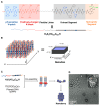Supramolecular Architectures of Nucleic Acid/Peptide Hybrids
- PMID: 33322664
- PMCID: PMC7763079
- DOI: 10.3390/ijms21249458
Supramolecular Architectures of Nucleic Acid/Peptide Hybrids
Abstract
Supramolecular architectures that are built artificially from biomolecules, such as nucleic acids or peptides, with structural hierarchical orders ranging from the molecular to nano-scales have attracted increased attention in molecular science research fields. The engineering of nanostructures with such biomolecule-based supramolecular architectures could offer an opportunity for the development of biocompatible supramolecular (nano)materials. In this review, we highlighted a variety of supramolecular architectures that were assembled from both nucleic acids and peptides through the non-covalent interactions between them or the covalently conjugated molecular hybrids between them.
Keywords: molecular hybrid; nanostructures; nucleic acids; peptides; self-assembly; supramolecular architectures.
Conflict of interest statement
The authors declare no conflict of interest. The funders had no role in the design of the study; in the collection, analyses, or interpretation of data; in the writing of the manuscript, or in the decision to publish the results.
Figures

















References
Publication types
MeSH terms
Substances
Grants and funding
LinkOut - more resources
Full Text Sources
Other Literature Sources
Medical

